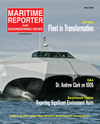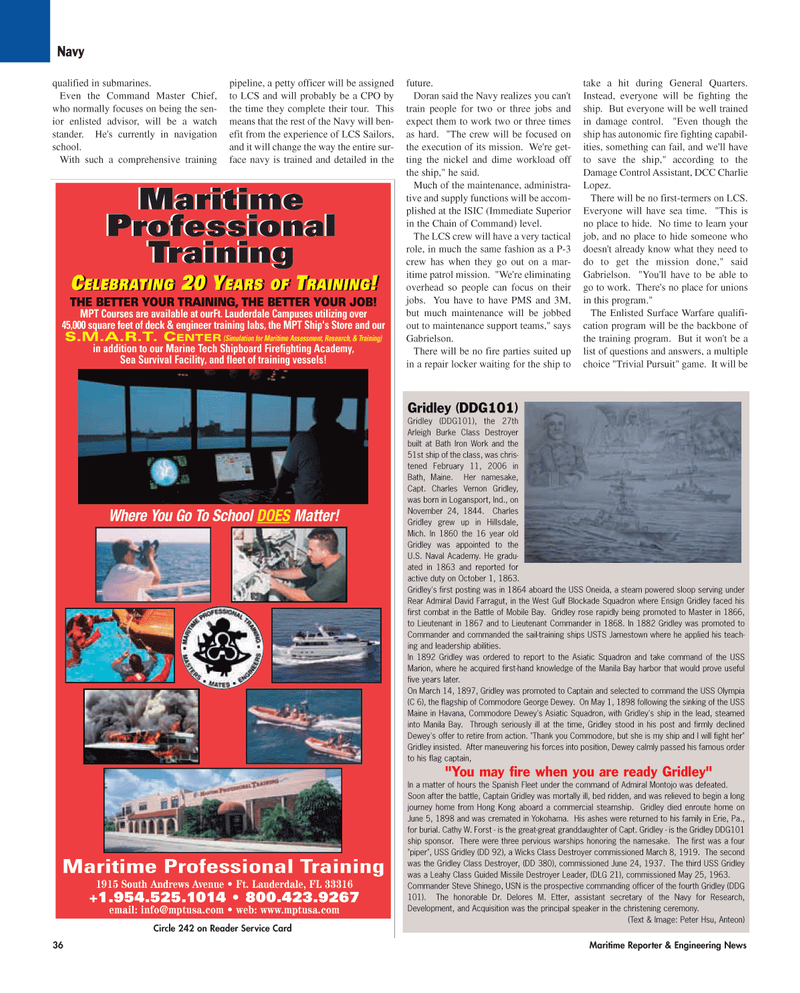
Page 36: of Maritime Reporter Magazine (March 2006)
The Training & Education Edition
Read this page in Pdf, Flash or Html5 edition of March 2006 Maritime Reporter Magazine
qualified in submarines.
Even the Command Master Chief, who normally focuses on being the sen- ior enlisted advisor, will be a watch stander. He's currently in navigation school.
With such a comprehensive training pipeline, a petty officer will be assigned to LCS and will probably be a CPO by the time they complete their tour. This means that the rest of the Navy will ben- efit from the experience of LCS Sailors, and it will change the way the entire sur- face navy is trained and detailed in the future.
Doran said the Navy realizes you can't train people for two or three jobs and expect them to work two or three times as hard. "The crew will be focused on the execution of its mission. We're get- ting the nickel and dime workload off the ship," he said.
Much of the maintenance, administra- tive and supply functions will be accom- plished at the ISIC (Immediate Superior in the Chain of Command) level.
The LCS crew will have a very tactical role, in much the same fashion as a P-3 crew has when they go out on a mar- itime patrol mission. "We're eliminating overhead so people can focus on their jobs. You have to have PMS and 3M, but much maintenance will be jobbed out to maintenance support teams," says
Gabrielson.
There will be no fire parties suited up in a repair locker waiting for the ship to take a hit during General Quarters.
Instead, everyone will be fighting the ship. But everyone will be well trained in damage control. "Even though the ship has autonomic fire fighting capabil- ities, something can fail, and we'll have to save the ship," according to the
Damage Control Assistant, DCC Charlie
Lopez.
There will be no first-termers on LCS.
Everyone will have sea time. "This is no place to hide. No time to learn your job, and no place to hide someone who doesn't already know what they need to do to get the mission done," said
Gabrielson. "You'll have to be able to go to work. There's no place for unions in this program."
The Enlisted Surface Warfare qualifi- cation program will be the backbone of the training program. But it won't be a list of questions and answers, a multiple choice "Trivial Pursuit" game. It will be 36 Maritime Reporter & Engineering News
Circle 242 on Reader Service Card
Maritime
Professional
Training
Maritime Professional Training 1915 South Andrews Avenue • Ft. Lauderdale, FL 33316 +1.954.525.1014 • 800.423.9267 email: [email protected] • web: www.mptusa.com
Where You Go To School DOES Matter!
THE BETTER YOUR TRAINING, THE BETTER YOUR JOB!
MPT Courses are available at ourFt. Lauderdale Campuses utilizing over 45,000 square feet of deck & engineer training labs, the MPT Ship's Store and our
S.M.A.R.T. CENTER (Simulation for Maritime Assessment, Research, & Training) in addition to our Marine Tech Shipboard Firefighting Academy,
Sea Survival Facility, and fleet of training vessels!
CELEBRATING 20 YEARS OF TRAINING!
Navy
Gridley (DDG101)
Gridley (DDG101), the 27th
Arleigh Burke Class Destroyer built at Bath Iron Work and the 51st ship of the class, was chris- tened February 11, 2006 in
Bath, Maine. Her namesake,
Capt. Charles Vernon Gridley, was born in Logansport, Ind., on
November 24, 1844. Charles
Gridley grew up in Hillsdale,
Mich. In 1860 the 16 year old
Gridley was appointed to the
U.S. Naval Academy. He gradu- ated in 1863 and reported for active duty on October 1, 1863.
Gridley's first posting was in 1864 aboard the USS Oneida, a steam powered sloop serving under
Rear Admiral David Farragut, in the West Gulf Blockade Squadron where Ensign Gridley faced his first combat in the Battle of Mobile Bay. Gridley rose rapidly being promoted to Master in 1866, to Lieutenant in 1867 and to Lieutenant Commander in 1868. In 1882 Gridley was promoted to
Commander and commanded the sail-training ships USTS Jamestown where he applied his teach- ing and leadership abilities.
In 1892 Gridley was ordered to report to the Asiatic Squadron and take command of the USS
Marion, where he acquired first-hand knowledge of the Manila Bay harbor that would prove useful five years later.
On March 14, 1897, Gridley was promoted to Captain and selected to command the USS Olympia (C 6), the flagship of Commodore George Dewey. On May 1, 1898 following the sinking of the USS
Maine in Havana, Commodore Dewey's Asiatic Squadron, with Gridley's ship in the lead, steamed into Manila Bay. Through seriously ill at the time, Gridley stood in his post and firmly declined
Dewey's offer to retire from action. "Thank you Commodore, but she is my ship and I will fight her"
Gridley insisted. After maneuvering his forces into position, Dewey calmly passed his famous order to his flag captain, "You may fire when you are ready Gridley"
In a matter of hours the Spanish Fleet under the command of Admiral Montojo was defeated.
Soon after the battle, Captain Gridley was mortally ill, bed ridden, and was relieved to begin a long journey home from Hong Kong aboard a commercial steamship. Gridley died enroute home on
June 5, 1898 and was cremated in Yokohama. His ashes were returned to his family in Erie, Pa., for burial. Cathy W. Forst - is the great-great granddaughter of Capt. Gridley - is the Gridley DDG101 ship sponsor. There were three pervious warships honoring the namesake. The first was a four "piper", USS Gridley (DD 92), a Wicks Class Destroyer commissioned March 8, 1919. The second was the Gridley Class Destroyer, (DD 380), commissioned June 24, 1937. The third USS Gridley was a Leahy Class Guided Missile Destroyer Leader, (DLG 21), commissioned May 25, 1963.
Commander Steve Shinego, USN is the prospective commanding officer of the fourth Gridley (DDG 101). The honorable Dr. Delores M. Etter, assistant secretary of the Navy for Research,
Development, and Acquisition was the principal speaker in the christening ceremony. (Text & Image: Peter Hsu, Anteon)
MR MARCH2006 #5 (33-40).qxd 3/2/2006 11:47 AM Page 36

 35
35

 37
37
